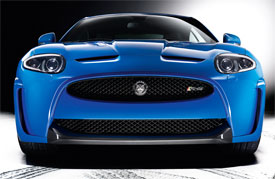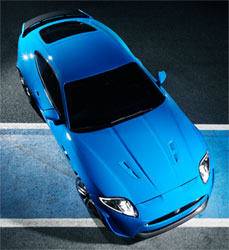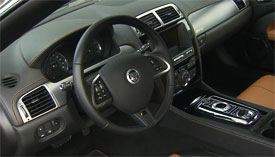2012 Jaguar XKR-S
According to Jaguar, the XKR-S is the fastest production car they’ve ever produced. Well, we couldn’t let a claim like that go by without seeing for ourselves. So, we headed to the place we know best to figure out such things out, Georgia’s Roebling Road Raceway, to find out if this cat is indeed their quickest yet!
Well, before we find out if this 2012 Jaguar XKR-S is indeed the fastest production Jaguar yet, let’s get to know it a little better.
 Based on the sleek Jaguar XKR coupe, the XKR-S takes on a more sinister look thanks to a healthy dose of performance enhancing treatments like carbon-fiber front splitter, blacked-out mesh grille, and both engine, and tall-slit-like brake cooling ducts that really visually widen the car. In profile, things take a turn to the dark side as well, with black window surrounds, fender vents, and beefy 20-inch wheels. Red brake calipers help avoid a total blackout. Out back, there’s a huge rear wing and below, a carbon-fiber rear diffuser wraps around two sets of dual exhaust tips from a Performance Active Exhaust System that really lets this cat purr.
Based on the sleek Jaguar XKR coupe, the XKR-S takes on a more sinister look thanks to a healthy dose of performance enhancing treatments like carbon-fiber front splitter, blacked-out mesh grille, and both engine, and tall-slit-like brake cooling ducts that really visually widen the car. In profile, things take a turn to the dark side as well, with black window surrounds, fender vents, and beefy 20-inch wheels. Red brake calipers help avoid a total blackout. Out back, there’s a huge rear wing and below, a carbon-fiber rear diffuser wraps around two sets of dual exhaust tips from a Performance Active Exhaust System that really lets this cat purr.
So, as great as Ian Callum’s original design was, we like it even more after this trip through “nasty” school. Okay enough of that, off to the track, or tracks, we go.
First stop is our hometown 75-80 Dragway for ¼-mile testing, where unfortunately, cold winter temperatures or maybe it was just the 550-horsepower, made launching a bit tricky. Eventually, we nailed a good one, and scorched to 60 in just 4.3–seconds. Streaking through the ¼ mile, this thing sounds absolutely awesome and unlike any Jag we’ve ever driven. It still feels like a Jaguar though, as the engine itself is smooth and quiet for the entire 12.6–seconds that it takes to reach the end of the strip at 118 miles-per-hour. Both acceleration times are a second quicker than the last XKR that we tested in 2007.
 Those quicker runs come courtesy of the 5-liter V8 engine under the hood wearing a Roots-type supercharger. It’s the same all-aluminum AJ-V8 you’ll find in the XKR, but it puts out 40-additional horsepower and 41-more pound feet of torque thanks to revised fuel mapping, making the new totals 550-horsepower and 502 pound feet.
Those quicker runs come courtesy of the 5-liter V8 engine under the hood wearing a Roots-type supercharger. It’s the same all-aluminum AJ-V8 you’ll find in the XKR, but it puts out 40-additional horsepower and 41-more pound feet of torque thanks to revised fuel mapping, making the new totals 550-horsepower and 502 pound feet.
After a comfortable and speedy 9-hour drive down I-95 we arrived at our next venue, Roebling Road Raceway, near Savannah, Georgia, where warmer temperatures weren’t the only thing that put smiles on our faces. Handling Roebling’s high speed turns? Oh yeah, this Jag’s got an app for that. The XKR’S aluminum chassis was already capable, but the XKR-S’ lowered suspension and new dampers take it to a whole new level.
Jaguar’s Adaptive Dynamics and DSC software get a sportier re-flash and there’s a new Active Differential Control. All of it helps to really put the power down out of corners. Steering feel, especially in Dynamic Mode, is about as good as it gets. You do feel the size of this car at times, mainly in tighter turns where the front tires take some abuse, but otherwise it’s one agile cat. Paddle shifters for the 6-speed automatic work well, but not well enough to forget that it’s a slush-box you’re manipulating and not a sequential manual.
 One thing that hasn’t been altered is the XK’s split personality. You can flog this beast around the track all day long, and then impress your significant other with a comfortable ride and posh interior that evening. And speaking of interior, the XKR-S’ does take a sportier turn, but not at the price of sacrificing luxury. There’s still leather everywhere, but now it’s accompanied by unique color stitching and aluminum trim.
One thing that hasn’t been altered is the XK’s split personality. You can flog this beast around the track all day long, and then impress your significant other with a comfortable ride and posh interior that evening. And speaking of interior, the XKR-S’ does take a sportier turn, but not at the price of sacrificing luxury. There’s still leather everywhere, but now it’s accompanied by unique color stitching and aluminum trim.
While technically not a limited edition vehicle, Jag expects to sell fewer than 100 XKR-S’s at a rarified price of $132,875; and there’s a convertible version arriving soon, as well.
So, the 2012 Jaguar XKR-S is indeed the fastest production Jaguar ever, and incredibly enough, it accomplished this without losing any “Jag-ness” along the way.
Specifications
- Engine: 5-liter V8
- Horsepower: 550
- Torque: 502 lb-ft.
- 0-60 mph: 4.3 seconds
- 1/4 mile: 12.6 seconds @ 118 mph
2024 Polestar 2
More Range And More Power For The Polestar 2
Volvo is well on their way to making the transition to an all-electric brand, but their sister-brand Polestar is already there. Now, we’ve spent lots of time in their all-wheel drive, five-door Polestar 2, having tested it in 2021, and a year later when a two-wheel drive version arrived. But, EV updates are coming quickly. So, let us be your guide for all that’s new with the Polestar 2.
While we are driving more EVs than ever, we’ve also been spending a lot of time recently circling back to ones we’ve previously tested. As in this new era of electrified vehicles, significant updates are arriving quickly, with R&D investments increasing and retrofitting them easier than ever. This is often done through software updates that can even be accomplished over the air. For 2024, the Polestar 2 has indeed gotten some software updates, but some physical ones as well.
Clearly aimed directly at Tesla’s Model 3 when it arrived; the Polestar 2’s build quality was vastly better, but range definitely came up short. So, addressing that was priority No. 1; and for ’24 the Polestar can travel up to 20% farther than before while consuming 9% less energy, and when it comes time to charge it back up, it can do that 34% faster too.
Range in the Single Motor version increases from a max of 270 to 320 miles thanks to a larger 82-kWh battery pack, and that solitary motor now powers the rear wheels, not the front wheels. It’s also bigger, coming in at 220 kW compared to the previous 170 kW front-wheel drive version, going from 231 to 299 horsepower.
Dual Motors keep the same 78-kWh battery, but still sees a boost from 260 to 276 miles and takes advantage of the larger rear motor for a new combined 310-kW output with 421 horsepower. Our test car has the added Performance Pack, which uses an additional 35 kW to deliver 455 horsepower and 546 lb-ft of torque, though max range drops to just 247 miles.
The new battery in rear-drive 2s will also charge faster, now accepting up to 205 kW for an 80% charge in 20 minutes; max for dual-motors stays at 155 kW, which puts an 80% charge at 34 minutes. Using 32 kWh of electricity per 100 miles, the Dual Motor earns a good efficiency rating.
The [Polestar] 2 has always been one of the most enjoyable EVs to drive, even more so now with that additional power coming from the rear motor.
Unfortunately, extremely cold temperatures kept us from seeing that increased range, as we were only on pace for about 194 miles in our test.
The 2 has always been one of the most enjoyable EVs to drive, even more so now with that additional power coming from the rear motor. And especially when equipped with the Performance Pack as it not only includes more power, but adds 20-inch forged wheels, upgraded brakes, and adjustable Ohlins Dual Flow Valve performance dampers. It greatly improves handling prowess without affecting ride quality, and is easily worth the $5,500 charge if you at all enjoy driving.
Even on a 20-degree track day there was plenty of grip through our handling course. No understeer or oversteer, and lots of feedback through the wheel. There was a nice, strong launch off the line that properly planted us firmly in the seat, and rocketed us to 60 in 4.5 seconds. Power delivery stayed pretty intense up until about 80 mph when there was a definite tapering off. Still, it was a 13.4-second quarter-mile at 102 mph; smooth, quiet, and stable the whole way.
When this car debuted, its Google-based infotainment setup was a novelty, but since then, more and more manufacturers are just “Googling it” so it doesn’t seem out of place at all. The wireless phone charger is easy to access, and there’s a great Harmon/Kardon sound system and panoramic sunroof to enhance the in-cabin experience. Exteriors have also been enhanced with a smooth grille insert and new wheel choices.
Hatchback practicality means 14.3 cu-ft of easy to access cargo space with split-folding seatbacks for longer items and expanding the space to 38.7 cu-ft. Plus, there’s even a sizeable storage bin up front under the hood.
Single Motor Polestar 2 pricing now starts at $51,300, with Dual Motors starting at $56,700; topping out at $64,400.
For a car manufacturer that hasn’t even been around for a decade yet, Polestar has kept itself busy, totally transforming their latest model in just a few years, making the 2024 Polestar 2 even more appealing. They are certainly off to a good start, and with a host of Polestars just over the horizon, including some all-important utility vehicles, this star will be shining even brighter.
Specifications
As Tested
- Motor Setup: Dual Motor
- Horsepower: 455
- 0-60 mph: 4.5 seconds
- EPA Range: 247 miles
- Efficiency : 32 kWh / 100 miles
- Battery Size: 78-kWh
- Torque: 546 lb-ft
- 1/4 Mile: 13.4 seconds at 102 mph
- MW Test Loop: ~ 194 miles
- Peak Charging Rate: 155 kW











































